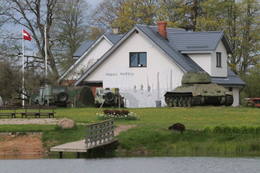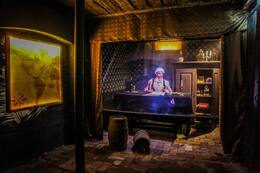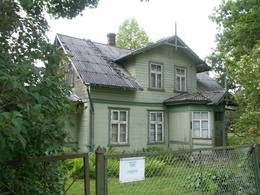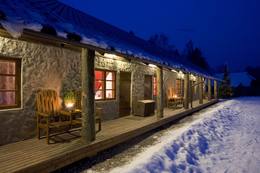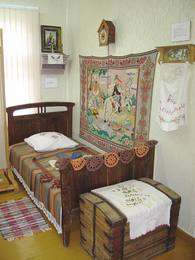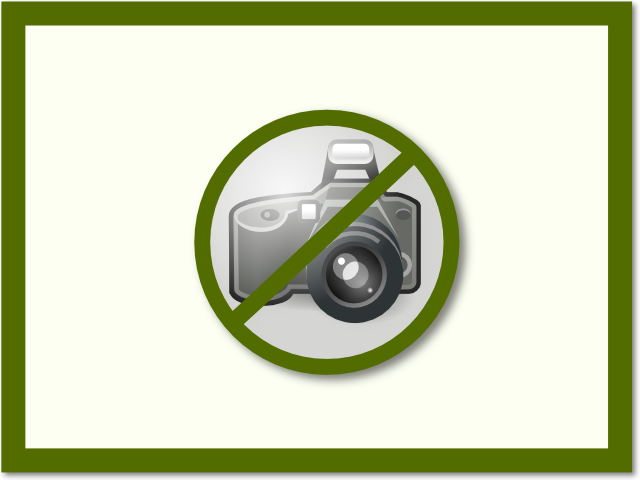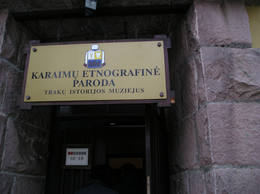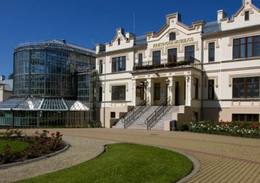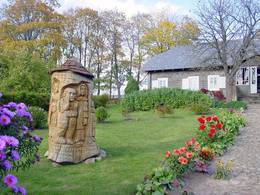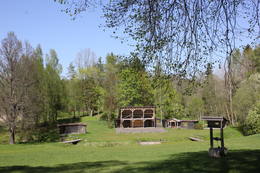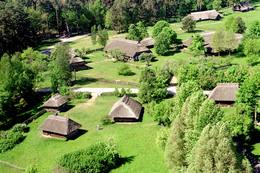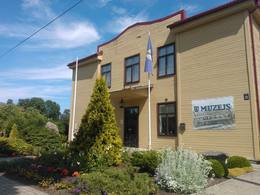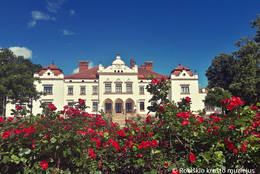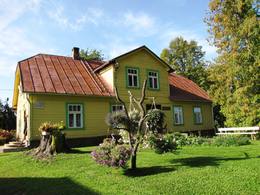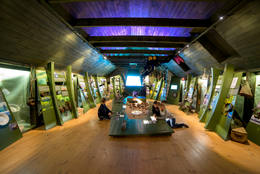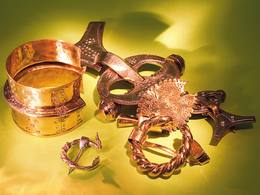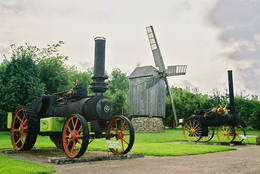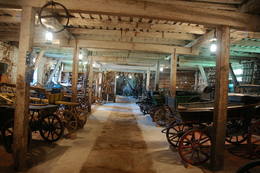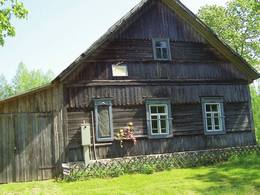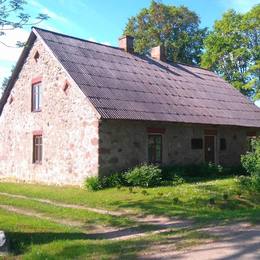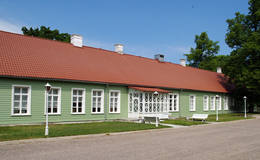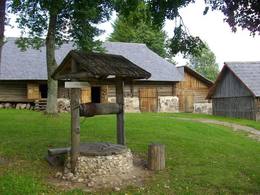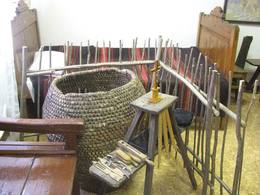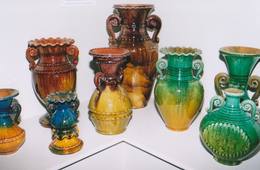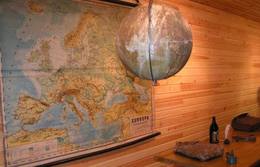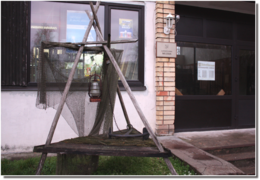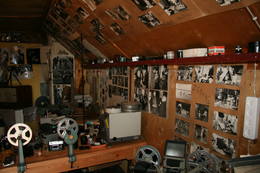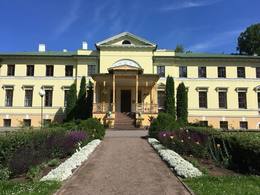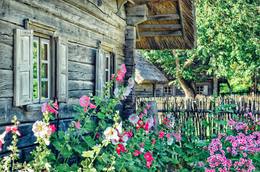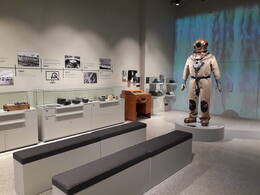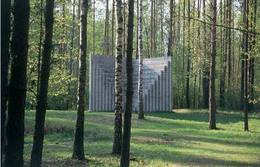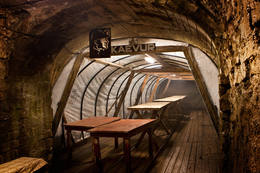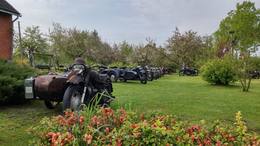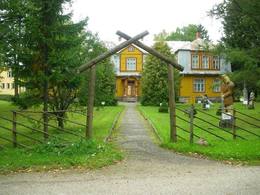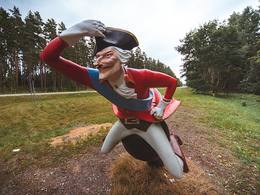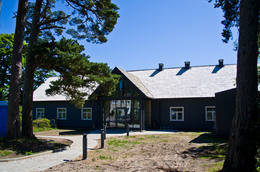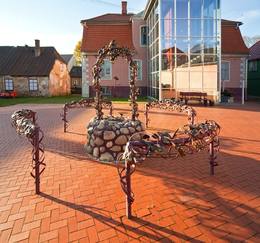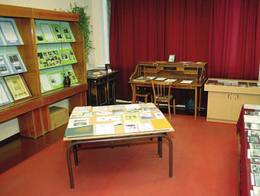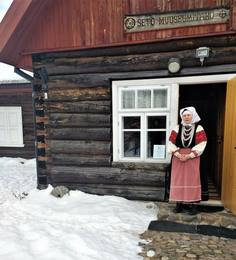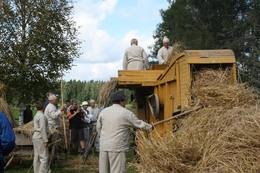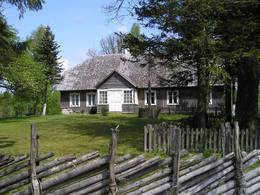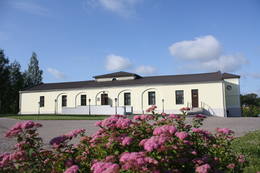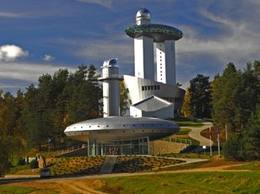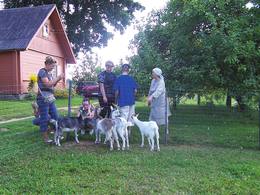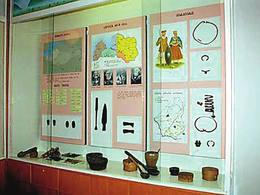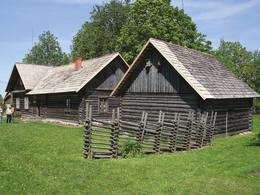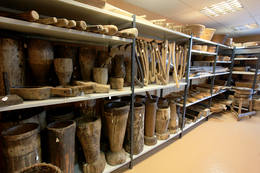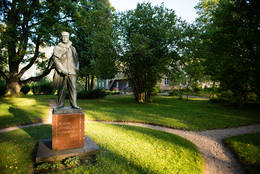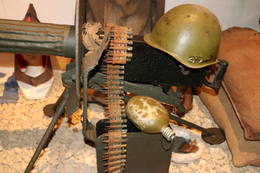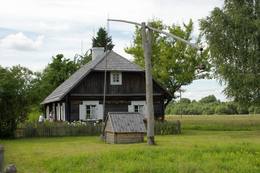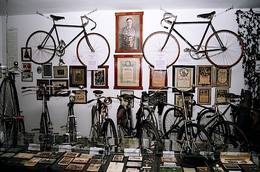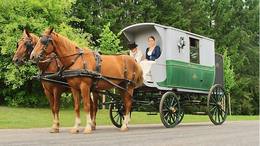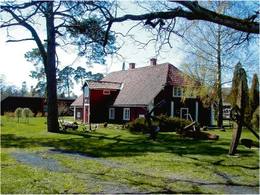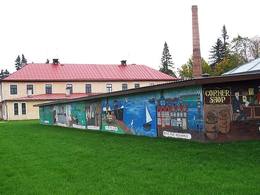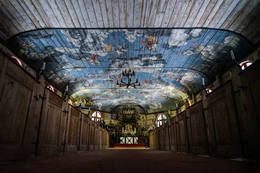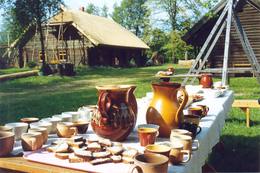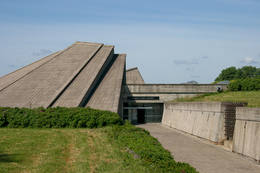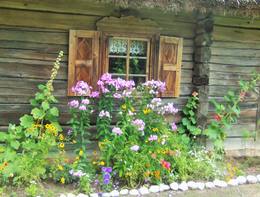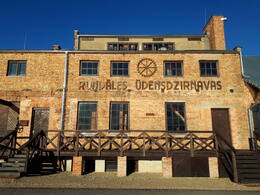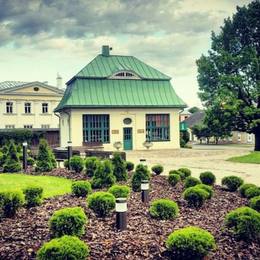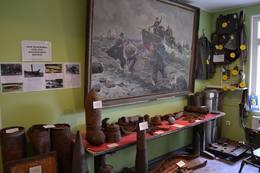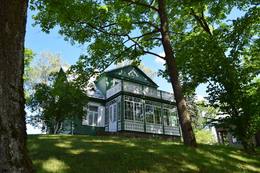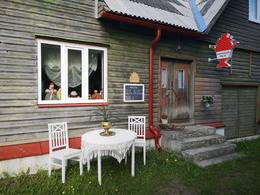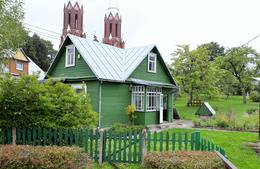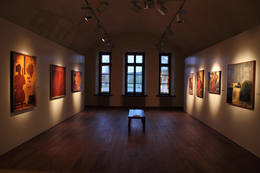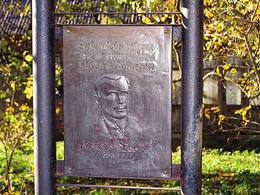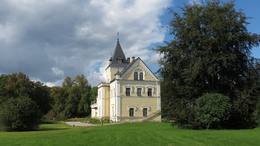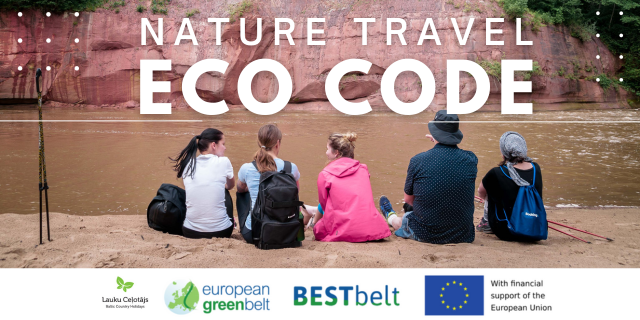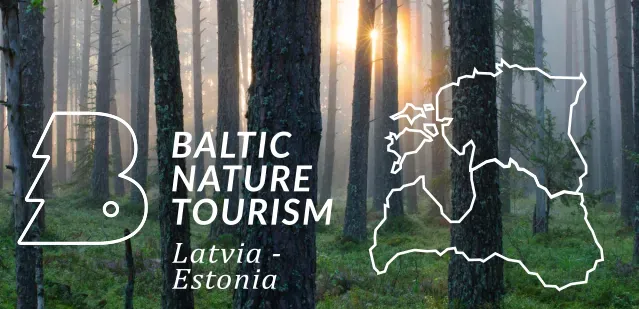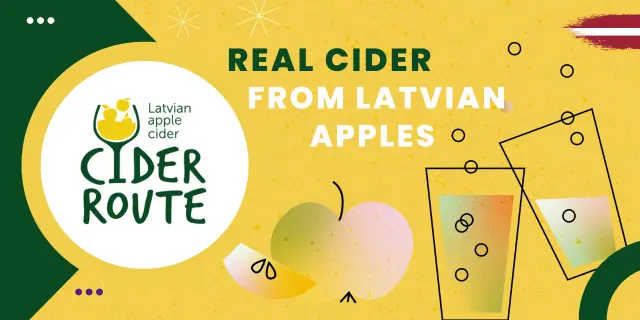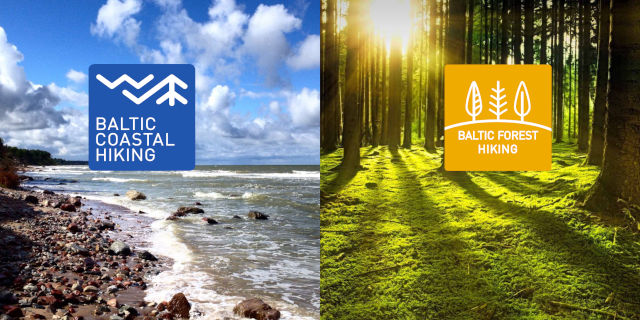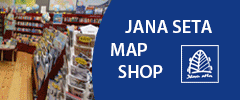Музеи
| Обзор | Подробности |
|---|---|
|
Латвия
Музей МоресМузей расположен в месте, где во время Второй Мировой войны шли бои между солдатами латышской и советской армий. В основе тематики музея – история латышского народа во время Второй Мировой войны и битва при Море.
|
|
|
Латвия
Live Museum “The story of Ancient Kuldiga”The tour at the “living Museum” is like a walk through history. Here, accompanied by a guide, it is possible to learn in interactive form about events during various periods in Kuldiga – about prison sentences, about Duke Jacob's ships, trade plans, about the glory and misery of Kuldiga. With the help of holograms, sound effects and other interactive elements, there is an opportunity to travel back in time and survive the sides of the history page full of joy, fear, horror and success. |
|
|
Латвия
"Пикши''Родной дом первого Премьер-министра и впоследствии Президента страны Карлиса Улманиса (1877 - 1942), где в 1993 г. был создан музей. За последние 20 лет "Пикши" пережили невероятное преобразование: благоустроен ландшафт местности, заново построены здания, которые были разрушены или находились в плохом состоянии. Здесь можно осмотреть жилое и хозяйственное строение, хлев – сарай, амбар. В зданиях размещена экспозиция, посвященная жизни К. Улманиса, а также богатая коллекция оборудования и инструментов для использования в сельском хозяйстве. Интересным экспонатом является самая большая деревянная маслобойка в Латвии. |
|
|
Эстония
Мельница-музей ХелленурмеНа единственной в Эстонии действующей водяной мельнице такого рода можно от начала и до конца увидеть процесс рождения хлеба. Сначала Вам покажут, как с помощью силы воды из зерен получают муку, а потом в пекарне под руководством хозяйки Вы сами сможете испечь хлеб. На экскурсии и курсы нужно записываться заранее. Также можно заказать еду. |
|
|
Латвия
Mузей Миервалдиса КемерсаMузей Миервалдиса Кемерса –
известному работнику культуры Латвии (1902
1980) – священнику и художнику посвящен
мемориальный музей на улице Дубрес 21.
|
|
|
Латвия
Senlietu privatkolekcija "Saipetnieki"Частная, созданная под открытым небом, коллекция старинных орудий труда, предметов быта и техники, начало которой положено в 2002 году. Сейчас в экспозицию входит более 5000 всевозможных культурно-исторических предметов и художественный сад, который простирается на площади более 2 га и включающий бесчисленные композиции роскошных цветов, фонтаны, восточный мостик для медитаций, пруды, перголу, беседки. Расположена в 1 км от Лаздукалнса. |
|
|
Латвия
A collection of military bicycles at the Saulkrasti Bicycle MuseumThis collection contains bicycles from five different armies and five different eras in the history of Latvia. They include a World War I bicycle from the Russian Empire, a bicycle from the Latvian army, two World War II German bicycles, and a Monark-brand military bicycle from Sweden that was donated to the renewed Latvian army in the 1990s. The exhibition also features items that are related to the use of military bicycles – seals, awards, and information about the bicycle units of Latvia’s Home Guard.
This is the only bicycle museum in Latvia, and its exhibits are unique, as well.
|
|
|
Эстония
Домашний музей туристического хутора ЛухтреОснованный в 1874-ом году хутор сегодня действует как туристическое предприятие, где гостей ждут уютные комнаты в помещении амбара, бани, открытый бассейн и натуральное питание, приготовленное по рецептам начала прошлого столетия. В музейной комнате хутора наследие прошлых поколений хуторян: от женского и детского белья с тончайшей вышивкой до домашнего инвентаря. Все предметы рассказывают свои истории о мечтах и делах своих прежних владельцев. |
|
|
Латвия
Музей-школа КубалуСамый старый из сохранившихся школьных домов в Латвии (1842 год.). Отремонтирован двор, тропы для прогулок, обстановка класса, камин. |
|
|
Латвия
Лиепайский музейВ фондах музея хранится более 120 000 предметов, экспозиция представляет историю Лиепаи и юга Курземе – начиная с каменного века и вплоть до 19-го века. Посетителям предлагается также экспозиция, посвященная жизни и творчеству скульптора по дереву Микеля Панкока (1894-1983). В других выставочных залах периодически проводятся выставки современного искусства. |
|
|
Латвия
Музей истории МалтыМузей истории Малты. Экспозиция „Малтская волость на грани веков от
Розентовы до Боровой и Малты”. Предлагаем ознакомиться с предметами
домашнего обихода, орудиями труда, предметами искусства, коллекцией
денежных знаков. Экскурсия вне музея „На излучинах р. Малты”.
Время работы: 9.00 – 17.00, Сб.,Воскр.: выходные |
|
|
Литва
Museum der Absurdität oder Orvidų sodybaIm Garten von Vilius Orvidas (1952 – 1992) ist eine Ausstellung der in der Sowjetzeit von der Melioration „geretteten” Steine, Grabkreuze, Holzgegenstände u.a. unter freiem Himmel eingerichtet. |
|
|
Эстония
Spielzeug-museum in TartuTraditionelle Spielzeuge von verschiedenen historischen Perioden und Völkern. |
|
|
Литва
Karaite Ethnographic MuseumKaraims are a small nation of Turkish decent who practise The Karaim religion which started developing around 8th century in Persia. Their language is still used in modern-day Lithuania. In the museum there are rooms not only dedicated to Lithuanian Karaite communities but also Poland's and Ukraine's. |
|
|
Латвия
Museum of Antiquities FazaniThe private museum of antiquities of Zigurds Safranovičš was founded in May 2010. The collection of the museum contains around 50 thousand objects, of which 99% of exhibits have been donated. The oldest and rarest, according to legend, 300-year-old item – Ernst Glick's refrigerator. The museum's surroundings are a large park of the former Baron Wulf's estate, where it is currently possible to spend the night in tents, as well as available rest areas - canopies, fire places, grills, utensils for cooking, etc., drinking water (from a well), available electricity for telephones, cameras, etc. for charging. For larger groups (starting from 10 people), porridge cooked on the fire. |
|
|
Латвия
Мемориальный музей Райниса «Ясмуйжа»В период с 1883 – 1891 гг. бывшую господскую усадьбу рода Шадурских арендовал отец Райниса Кришьянис Плиекшанс. Молодой поэт Райнис провел здесь молодые годы, что отражено в «земле молодых дней» поэта. В «Ясмуйже» переведена драма A. Пушкина «Борис Годунов». За вклад поэта в 1964 году в доме управляющего господской усадьбой создана экспозиция «Гимназические и студенческие годы Райниса». В восстановленном хлеве господской усадьбы выставлены работы гончаров Латгалии. «Ясмуйжу» стоит посетить в Дни поэзии или во время открытия печи (в июне и августе). |
|
|
Латвия
Мемориальный дом Андрея УпитисаНаходится в Скривери, на ул. Даугавас 58. Первый дом писателя (1877 – 1970) был построен в 1908-м году, а ныне существующий дом – в 1921-м году на фундаменте первого дома. В здании расположен музей, экспозиция которого отражает жизненный путь и творчество писателя, а также ход создания романа «Зеленая земля». Рядом с домом раскинулся сад. В 1952-м году А. Упитис дом с садом подарил государству. Предлагаются экскурсии и музейно-педагогические программы. |
|
|
Латвия
A collection of antiquitiesAt a lovely place in the Gauja National Park in the Vaidava Parish, guests can examine ancient tools, mechanisms and household objects. Guides will talk about how these various items were used. There is a guesthouse for overnight accommodations, and there is room for tents and picnics.
|
|
|
Латвия
Яунпиебалгский краеведческий музейОткрыт в 1977 году в старинном деревенском доме, покрытым тростниковой крышей. Экспозиция музея рассказывает о выдающихся людях этой области, событиях, истории и традициях. |
|
|
Литва
ПАРК УСАДЬБЫ КРЕТИНГАПарк усадьбы Кретинга — один из старейших усадебных парков Литвы, сохранившихся с XVI–XVIII вв. Это парк смешанного стиля площадью 23 га. В южной части усадебного парка на месте бывшего фруктового сада установлен Астрономический календарь с солнечными часами, сформирована живая изгородь, проложены аллеи, разбиты клумбы, альпинарии, выращиваются коллекции георгинов, пионов, тюльпанов, восстанавливаются фрагменты розария, оборудованы пешеходные дорожки, места для отдыха. Отреставрированный фонтан усадьбы стал излюбленным местом для отдыха посетителей. |
|
|
Литва
УСАДЬБА-МУЗЕЙ ЛЮДВИКИ И СТАНИСЛОВАСА ДИДЖЮЛИСОВМемориальная усадьба-музей Людвики и Станисловаса Диджюлисов находится на хуторе Грежёнеляй в Аникшчяйском районе. Музей открыт в 1968 г. Это aутентичная усадьбa с характерным для того времени озеленением, где история переплетается с объектами биологического наследия. |
|
|
Латвия
Силмачи ДрувиеныДо Силмачи нужно ехать через бор в Перлисе и через малонаселенные места. Здесь в 80-х годах 20 века построена эстрада под открытым небом для одного спектакля Рудольфа Блауманя „Дни портных в Силмачи”, который ставился в Латвийском национальном театре в 1986 году на праздник Лиго . Рядом с эстрадой также в 1986 году создан музей, посвященный данной тематике, в котором, наряду с другими экспонатами, можно увидеть также рукопись пьесы сохранившись с 1902-го года. |
|
|
Литва
RumsiskėsCountryside life open-air museum. Various historical county buildings, everyday life tools, traditions etc. |
|
|
Латвия
Mezniecibas muzejs EglavaThe museum at Egļava has an exhibition about forestry in Latvia before and after World War II. The exhibit features forestry tools and equipment, as well as textiles from the former Balvi District along with samples of ceramics and woodworking. The former forest ranger house has rooms to provide accommodations to guests. |
|
|
Латвия
Ройский музей морского рыболовстваОдин из главных остановочных пунктов на Северокурземском побережье, где можно получить обширную информацию и представление об истории края и побережья, культурно-исторических ценностях, строительстве парусников, традициях рыболовства, людях этого края, их труде и заслугах. Музей в Рое был основан в 1968-м году. В настоящее время можно осмотреть постоянные экспозиции о Кришьяне Валдемаре, мореходной школе в Рое и строительстве парусников в 19-м веке. Создана также экспозиция об истории рыбообработки с 19-го века до наших дней, Ливском береге, о советском вкладе в развитие побережья. Кроме осмотра основной экспозиции еще можно «познакомиться» с тремя жительницами Курземе, представляющих различные исторические периоды: Милдочка – простая жена рыбака c побережья, госпожа Паулиня со времен парусников и Анна Петровна с советского времени. Они увлекательно знакомят с предметами, не представленными в музее и со «скверным» юмором жителей Курземе. (Источник: Ройский ТИЦ) |
|
|
Латвия
Латгальский культурно-исторический музейНаходится на аллее Атбривошанас, д. 102, в Резекне.Музейный фонд отображает историю города на протяжении семи столетий. Представлена большая характерная для Латгальского края коллекция керамики и изобразительного искусства. Экспозиция «Чудо из глины, рожденное в огне» знакомит с историей возникновения и развития керамики, а в гончарных дворах и мастерских можно наблюдать за процессом создания глиняных изделий. Рядом с музеем установлен памятник выдающемуся поэту Латгалии Антону Кукойю (1940 – 2007). |
|
|
Латвия
Latvian Agriculture museumМузей был создан для того, чтобы создавать представление о Латышской сельской среде, знакомить с историей развития отраслей сельского хозяйства, распространять материальные и нематериальные свидетельства ведения сельского хозяйства и жизни на селе в Латвии с конца 19-го века до наших дней. Интерес посетителей подогревается широким спектром сельскохозяйственной техники для обработки и ухода за землей, для сбора урожая, а также различными инструментами. |
|
|
Латвия
A museum or forestry and household tools at KleperiThe Lejas Kleperi farm straddles the boundary between the Cēsis and Valka Districts. The farm is 119.4 hectares large, with 86.1 hectares of forestland. The farm’s work is centred on forestry. In 1992, a private museum of farming and forestry equipment was set up in one of the residential buildings. The museum’s collection is constantly being updated.
|
|
|
Литва
РОКИШКСКИЙ КРАЕВОЙ МУЗЕЙ И УСАДЬБАРокишкский краевой музей и усадьба представляют собой один из важнейших культурных центров Аукштайтии. Величественность дворца подчеркивается парком и прудами. |
|
|
Латвия
Музей Кулдигского краяНа берегу Венты возвышается настоящая жемчужина деревянной архитектуры – окутанная романтическими историями и легендами, недавно восстановленная "Вилла Бангерта". Говорят, что это здание в качестве подарка своей невесте в Париже купил некий капитан Бангерт. С 1940 года в здании находится краевой музей Кулдиги. После реконструкции в музее восстановлены уникальные росписи стен и другие детали интерьера, устроена экспозиция - квартира семьи Бангертов, которая позволяет узнать, как жили зажиточные жители Кулдиги в начале 20 века. Здесь можно осмотреть часть коллекции карточных игр коллекционера Яниса Метры. |
|
|
Латвия
Памятная комната Петериса БарисонаСоздана в родном доме «Скудрас» латышского композитора и дирижера Петериса Барисона (1904 – 1947). В экспозиции есть личные вещи композитора, музыкальные инструменты, документы и другие свидетельства. Экскурсии по предварительной записи. |
|
|
Латвия
Daugavpils novadpetniecibas un makslas muzejsAtrodas Rīgas ielā 8 – skaistā, 1883. g. celtā jūgendstila ēkā . Muzejs (viens no Latgales lielākajiem un vecākajiem) tajā darbojas no 1959. g. (pats muzejs dibināts 1938. g.) un tā krājums vēsta par Daugavpils un tās apkārtnes vēsturiskajiem notikumiem. Tajā regulāri tiek rīkotas arī tematiskās izstādes, piedāvātas muzejpedagoģiskas programmas. Te vēl var apskatīt Daugavpilī dzimušā un pasaulē pazīstamā mākslinieka Marka Rotko (1903. – 1970.) gleznu reprodukcijas, kuras no 2013. gada plānots pārcelt uz M. Rotko centru Daugavpils cietoksnī. |
|
|
Латвия
Музей штормаНаличие Балтийского моря являлось причиной одного из древних названий Юркалне - Феликсберг. До настоящих дней увлекательной остается легенда, повествующая о происхождении этого слова. В Балтийском море у Юркалне было найдено множество обломков затонувших кораблей. |
|
|
Латвия
Музей Малтской 2-й средней школыМузей Малтской 2-й средней школы. Галерея украшений
древних латгальцев 6 – 13 веков.
Время работы: 9.00 – 16.00, Сб.,Воскр.: выходные |
|
|
Эстония
Эстонский музей сельского хозяйстваГордостью музея, расположенного вблизи Тарту, в мызном комплексе Юленурме, является уникальная коллекция сельскохозяйственной техники и экспозиция «Развитие сельского хозяйства и сельской жизни в Эстонии через столетия». Еще работают выставки пчеловодства, транспортных средств крестьян, соломы и бересты. Музей предлагает всем заинтересованным лицам различные обучающие программы и курсы (кузнечное дело, реставрация дерева, изготовление мебели из природных материалов, приготовление ржаного хлеба, национальное ремесло и т. д.). Группам по предварительному заказу предлагаются эстонские национальные блюда. |
|
|
Эстония
Музей гужевых повозокМузей гужевых повозок расположен на скотоводческой мызе Пилькусе. Экспонатами являются телеги, одноколки, сани, а также их снаряжение (дуги, оглобли, бубенцы, санные одеяла и специальные болотоступы для лошадей). Среди экспонатов есть также тачанка, карета скорой помощи и пожарная карета.Самыми яркими экспонатами являются карета и коляска, еще имеется большое количество сельскохозяйственных орудий труда. Есть что посмотреть, интересных экспонатов с избытком. |
|
|
Латвия
Лудзинский краеведческий музейНаходится на северо-восточном берегу Малого Лудзенского озера. В экспозиции под открытым небом представлен жилой дом крестьянина (курная изба), жилое здание, ветряная мельница, овин и мастерская керамиста Поликарпа Вилцанса. Здесь проводятся различные мероприятия, связанные с ремесленничеством и культурными событиями. Рядом с музеем находится пристань с плотом для прогулок по Малому Лудзенскому озеру (предварительная заявка) и место для отдыха. |
|
|
Латвия
Дом-музей писателя Михаила НарицыДом-музей писателя Михаила Нарицы. В доме-музее четыре
раза репрессированного писателя М. Нарицы можно ознакомиться
с историей политических репрессий в СССР и в Советской Латвии,
а также с работами лауреатов конкурсов, организованных центром,
названным именем М. Нарицы.
Время работы: по договоренности |
|
|
Латвия
"Spridisi"Atrodas Tērvetes ziemeļrietumu daļā, Tērvetes upītes krasta līkumā. „Sprīdīšos” sava mūža pēdējo desmitgadi (no 1922. līdz 1933. g.) strādāja un atpūtās latviešu rakstniece Anna Brigadere (1861. - 1933). Šajā laikā top lugas, stāsti, dzejoļi un rakstnieces atmiņu triloģija. No laukakmeņiem celtā „Sprīdīšu” ēka uzbūvēta 1840 g. Te sākotnēji darbojušās ūdensdzirnavas, tad skola, dzīvojuši mežziņi. Tagad šeit aplūkojams rakstnieces memoriālais muzejs. No „Sprīdīšiem” var uzsākt garāku pastaigu pa Tērvetes dabas parku, kur izvietoti no koka darinātie A. Brigaderes pasaku varoņi. |
|
|
Латвия
Jana Zabera muzejs "Vecais Ceplis"Operdziedātāja Jāņa Zābera muzejs "Vecais ceplis" atklāts 1973. gada 11. augustā - dziedātāja dzimšanas dienā - viņa dzimtajās mājās. Muzejā apskatāmas fotogrāfijas no viņa dzīves gājuma, afišas un operu tērpi. Tāpat pieejami dziesmu un operu āriju ieraksti mākslinieka izpildījumā. Muzeju pārzina Jāņa Zābera brāļa meita ar ģimeni. To ir iespējams apmeklēt, iepriekš saskaņojot laikus.
|
|
|
Эстония
Музей ХийумааВ основном здании уездного музея (открыт круглогодично) и его филиалах (открыты в летний период) дан обзор истории возникновения Хийумаа, обзор истории мореходства, сельского хозяйства и мыз, рассказано о царском и Эстонском временах, истории шерстяной фабрики в Кярдла, советском времени и о многом другом интересном. В Длинном доме можно проводить уроки по традиционной культуре. |
|
|
Латвия
Profesora Aleksandra Biezina muzejs “Jaundilmani”Pusceļā starp Madonu un Cesvaini, Sarkaņu pagasta Biksēres “Jaundilmaņos” dzimis Latvijas Bērnu ķirurģijas pamatlicējs, traumatalogs un ortopēds, izcils bērnu ārsts Aleksandrs Bieziņš (1897.-1975.). Tagad viņa dzimtajās mājās ierīkots muzejs, Paula Stradiņa Medicīnas vēstures muzeja filiāle. |
|
|
Латвия
Priekules senlietu kratuveAtrodas Skolas ielā 12, Priekules pamatskolā. Tās krājumā ir plašs Priekules novadā iegūto vēsturisko liecību klāsts – sadzīves priekšmeti, darbarīki, dokumenti, padomju gados izsūtīto un represēto cilvēku atmiņu stāsti u.c. liecības, kā arī Priekules skolu attīstības vēsture. |
|
|
Эстония
Музей крестьянского быта ПылваЭто своеобразный музей на открытом воздухе в Южной Эстонии, где можно познакомиться с крестьянской и школьной жизнью конца 19-го - начала 20-го века. На музейной территории в 5 га можно увидеть здания школы, суда, бедного дома с надворными постройками, зернохранилища, жилой риги и дома бобыля, а также ветряную мельницу голландского типа. Представлены сельскохозяйственные машины и средства передвижения. |
|
|
Латвия
Дом Эдварда Вирзы «Биллитес»Примерно в 6 км к юго-западу от Иецавы находится дом отца Эдварда Вирзы (настоящее имя - Екабс Эдуардс Лиекна) (1883-1940) "Биллитес", в который писатель и его жена Элза Стерста переехали в 1901 году. Э. Вирза был одним из величайших писателей, поэтов, прозаиков, публицистов и переводчиков 20-го века. Многие из стихотворений были написаны в "Биллитес", а в 1933 году здесь появилась на свет легендарная работа «Страумени», изображающая жизнь латышского крестьянства. В "Биллитес" создан музей Э. Вирзы. Его основателями являются дочь Э. Вирзы и Э. Стерсты Амарилис Лиекна с сыном Эдвардом Лиекной, дочерью Анной Жигуре и внучкой Дианой. Предварительно договорившись о посещении, желающие могут ознакомиться с музеем и творчеством Э. Вирзы. |
|
|
Латвия
Мадонский краеведческий и художественный музейОдин из старейших музеев Видземе, самые интересные экспонаты которого – это находки времен Cреднего и Раннего железного века, часть которых была найдена в окрестностях озера Лубанас. Работники музея организуют как тематические, связанные с историей культуры края, так и художественные выставки. Музей расположен в исторических зданиях бывшего имения Биржу. |
|
|
Латвия
Мемориальный музей Карлиса Скалбе „Саулриеты”„Саулриеты” находится в живописном месте – на горе Инцены, где создан мемориальный музей автора легендарной латышской сказки «Кошкина мельница» Карлиса Скалбе (1879 - 1945). Музей находится в построенном в 1926 году летнем доме поэта и прозаика, где он проводил летние каникулы в период с 1926 – 1944 годы. На западном склоне находящейся рядом горы Вактскалнс в 1992 году был перезахоронен прах умершего в Швеции Карлиса Скалбе и его супруги Лизеты Скалбе, где создан своеобразный памятник в форме каменной лодки. |
|
|
Латвия
Наутренский краеведческий музейНаутренский краеведческий музей. Постоянная экспозиция об
истории края, его культуре, образовании и истории волости.
Время работы: по договоренности |
|
|
Латвия
Мастерская– музей Поликарпа ЧернявскогоРасположен в юго-западной части Прейли, по адресу ул. Талсу 21. Экспозиция музея посвящена работам гончара П. Чернявского (1923 – 1997), которые выделяются своей светлой, желтоватой и яркой глазурью. Посетители музея могут участвовать в процессе создания керамических изделий (в т.ч. открытие печи) и приобрести сувениры. |
|
|
Латвия
Krivu klets muzejsSaimniecības zemi, kas atrodas starp Ulbroku un Vālodzēm, 1929. gadā nopirka tagadējā saimnieka – Dzintara Āboliņa vectēvs. Tajā laikā arī tika uzcelta klēts, kurā glabāja saimniecībā izaudzēto lauksaimniecības produkciju. Krīvu klēts atdzimšana notika pirms 20 gadiem, kad tagadējie saimnieki tajā uzsāka veidot muzeju no sadzīves priekšmetiem un darba instrumentiem, kas savulaik izmantoti Krīvu saimniecībā. |
|
|
Латвия
Bauskas Novadpetniecibas un makslas muzejsAtrodas Bauskas centrā, Kalna iela 6. Muzeja piedāvājumā ir ekspozīcija „Bauska laikā un cilvēki Bauskā 20 gs., pastaiga un atraktīvs piedzīvojums”. |
|
|
Эстония
Хутор-музей СиллаотсаВ основанном в 1982-ом году музее можно познакомиться с жизнью и бытом данного региона начиная со второй половины 19-го века до недавнего прошлого. В парках на 17 га музейной территории можно увидеть 200 различных видов деревьев и кустарников. Можно поучаствовать в различных тематических днях- испечь хлеб или познакомиться с датами Эстонского народного календаря. Из музея можно попасть на природную и культурологическую учебную тропу Велизе. |
|
|
Литва
MosėdisEine Asstellung der Steine unter freiem Himmel, eingerichtet vom litauischen Ärzt Intas Vaclovas (1925 – 2007). Ein Museum der einzigartigen Steine. |
|
|
Латвия
Лапмежциемский музейЛапмежциемский музей –
ознакомление с историей развития волости,
школы и рыболовства, а также материалы о
борьбе финских егерей в окрестностях
Клапкалнциемса. В музее организованы
тематические выставки. Рядом памятный
камень политически репрессированным.
|
|
|
Литва
MeeresmuseumDas Museum befindet sich in der Festung von Kopgalis. Im Aquarium des Museums sind Fische und Tiere der Ostsee und anderer Meere und Ozeane zu sehen. Eine Ausstellung. Pinguine und Seehunde. In den Pulverkellern der Festung ist eine Ausstellung der Seefhrt Litauens, aber auf den Bollwerken eine Ausstellung der Gewehr eingerichtet. Das einzige Delfinarium im Baltikum. |
|
|
Латвия
Экспозиция истории кино и фотографииНаходится в Букупе (Салдусский край, Зирньская волость) в сельской усадьбе «Зики». Можно осмотреть коллекцию кино и фото экспонатов, собранную хозяином усадьбы Андрисом Бушинскисом. Коллекция включает старинные устройства для создания фильмов и предметы, демонстрирующие процесс фотографирования и киносъемки. Экспозиция размещена в бревенчатой постройке в виде пчелиных сот, построенной хозяином. |
|
|
Латвия
Nauksenu CilvekmuzejsНаукшенский Музей человека. Место, где мы рассказываем думающим людям, как родившиеся, пришедшие и оставшиеся в земле «НАУКШЕНСКОГО ДИСКО» говорят, поют, думают и любят. |
|
|
Литва
КЛЕБОНИШКСКИЙ МУЗЕЙ ДЕРЕВЕНСКОГО БЫТАМузей деревенского быта был основан в 1991 г. на территории в 18 га, где Аукштайтийский регион представлен аутентичными усадьбами |
|
|
Латвия
Кегумская ГЭС и Музей энергетикиThis exhibition features the Pļaviņas hydroelectric power plant as a unique architectural building with unique engineering elements. It is the largest producer of electricity in the Baltic States and one of the largest in
|
|
|
Литва
Park von EuropaDas Museum vom Zentrum Europas. Gegründet vom litauischen Bildhauer Gintaras Karosas. Mehr als 100 von Künstlern aus den 33 Ländern errichtete Installationen sind unter freiem Himmel ausgestellt. |
|
|
Латвия
Academia Petrina и Елгавский музей истории и искусства Гедерта ЭлиасаТеперешнее здание (позднее барокко, ранний классицизм) было построено по инициативе герцога Курземе и Земгале Петера Бирона в период с 1773 – 1776 годы (датский архитектор Северин Енсен) на месте, где располагался дворец герцогини Анны. В 1775 году здесь было основано первое в Латвии высшее учебное заведение Academia Petrina (Академия Петра - названа так в честь ее основателя), а в 1782 году - создана первая обсерватория. Во времена Российской империи здесь находилась гимназия. Среди ее выпускников стоит упомянуть таких, как К.Баронс, Ю. Алунанс, Я.Чаксте, А.Сметонс и др. В 1952 году в здании гимназии основали Елгавский музей истории и искусства, которому в 1975 году было присвоено имя классика латышской живописи Гедерта Элиаса (1887 – 1975). Экспозиция музея рассказывает об истории города и края в период Курземско-Земгальского герцогства и после него. У впечатляющего здания расположены четыре пушки времен Курземского герцогства и памятник Г. Элиасу (1987 год, скульптор И. Зариньш), а также фрагмент памятника освободителям Елгавы “Лачплесис и Чёрный рыцарь”, изготовленный скульптором К. Янсоном. |
|
|
Латвия
Науенский краеведческий музей и парк ЮзефовасНаходится в Науене, на обочине шоссе Даугавпилс - Краслава (А 6). В коллекции этнографического музея представлена экспозиция «Комната богатого латвийского крестьянина» с предметами быта 19-20 в.в. Самым маленьким посетителям будет интересна уникальная диорама «Подводный мир», где можно увидеть подводных жителей Даугавы. Природная экспозиция «Сирдс Даугава» знакомит с природными и культурно-историческими ценностями особо охраняемых природных территорий - природного парка «Даугавас Локи» и охраняемой ландшафтной зоны «Аугшдаугава». Музей предлагает творческие мастерские и музейно-педагогические программы. На востоке от музея есть яблоневый сад. На другой стороне дороги расположился благоустроенный парк Юзефова, в котором находился построенный графом Богданом Шахно усадебный замок, до наших дней не сохранившийся. В парке Юзефова проложены пешеходные дорожки, оборудованы места отдыха, информационные стенды, которые повествуют об истории парка и самых интересных видах деревьев. Прогулка по парку займет не менее часа. |
|
|
Латвия
Xранилище старинных предметов в НицеXранилище старинных предметов находится на втором этаже здания Туристического информационного центра в Нице. Здесь представлен более чем столетний народный костюм Ницы со всеми неотъемлемыми принадлежностями - юбкой, корсажем, кафтаном и шапкой с «ушками». В ницанском сундуке для приданого хранятся работы местных рукодельниц, которые продолжают местные ремесленнические традиции. Посетители могут ознакомиться с ницанскими одеялами, платками, скатертями и другими пригодными в хозяйстве вещами, а также с рукавицами и носками. |
|
|
Эстония
Кохтлаский шахтерский парк-музейСамым захватывающим аттракционом Кохтлаского шахтерского парка-музея является подземный музей. Во время подземного путешествия Вы посетите различные места работы и отдыха шахтеров, склады взрывчатки, прокатитесь на настоящем подземном шахтерском поезде и познакомитесь с различной подземной техникой и технологией добычи сланца. Посетители могут заказать себе вкусный обед шахтера и съесть его в настоящей подземной шахтерской столовой. |
|
|
Латвия
SIA “North Latgallian Firewood” / Biedriba "Rusa veja"SIA “North Latgallian Firewood” darbības pamatnozare ir mežsaimniecība un kokmateriālu sagatavošana - uzņēmumā nodarbojas ar malkas sagatavošanu un tirdzniecību, kā arī piedāvā malkas gabalošanu un skaldīšanu izbraukumā pie klienta. Uzņēmuma piedāvātie pakalpojumi – malkas sagatavošana, malkas tirdzniecība lielos apjomos, kokmateriālu sagatavošanas pakalpojumi. Brīvajā laikā uzņēmuma īpašnieks restaurē senus motociklus un ir izveidojis plašu retro motociklu un senlietu kolekciju. |
|
|
Латвия
Mikjanu setaМесто отдыха находится в историческом местечке «Кони» поселка Папе Южного Курземе. Место для ночлега - клеть, историческая постройка с тростниковой крышей, приспособленная для проживания поздней осенью / летом / ранней весной. 3 комнатки + небольшая передняя и кухня на двух этажах. Предназначена для 8 человек. Идеальное место для проведения творческих лагерей, пленэров, мастерских и других культурных мероприятий. Места для палаток, где можно принять до 80 человек. Двор «Микьяну» в сотрудничестве с группами по интересам «Клуба традиций Руцавы» предлагает по предварительной договоренности попробовать блюда местной традиционной кухни – «селедку на углях», белое масло с вареной картошкой, риезу (картофельную запеканку с луком и салом, а иногда и без мяса), уху и др. Предложение распространяется только на группы, по предварительной договоренности. |
|
|
Эстония
Музей КалевипоэгаКалевипоэг- герой Эстонского национального эпоса, и именно Йыгевамаа тесно связано с историями о нем. Здесь меч Калевипоэга в реке Кяапа, места отдыха, камни, родники, болота, вспаханные борозды, следы лошади и т. д. В музее Калевипоэга 12 тематических комнат, где представлены связанные с ним материалы и Эстонское культурное наследие. Перед зданием музея- заповедный сад и 17 деревянных скульптур героев эпоса. |
|
|
Латвия
Музей МюнхгаузенаВ восстановленном хозяйском доме поместья Дунтес разместилась музейная экспозиция, которая знакомит посетителей с приключениями и жизнью легендарного выдумщика и короля всех лжецов барона Мюнхгаузена. Первый этаж музея посвящен барону Мюнхгаузену и его историям, а на втором этаже можно осмотреть экспозицию восковых фигур выдающихся личностей из истории Латвии, а также самую большую в Латвии коллекцию пивных кружек. В лесу разбиты три кольца троп с деревянными скульптурами, самая длинная из троп ведет до самого моря. Детей привлечет деревянный корабль аттракционов. |
|
|
Латвия
Livonian Community HouseLivonian Community House at Kolka was opened in 2019. It is a place where you can get to know the Livonian culture of Northern Kurzeme, learn about traditional activities, listen to the sound of the language, and get an idea of the cultural and historical heritage of the coast. In House you can organize and attend cultural events, seminars, trainings, exhibitions, and also receive tourism information. |
|
|
Эстония
Хутор-музей СоэраПостроенная в начале 19-го века жилая рига с земляным полом - старейшее здание музея. Жилое помещение с комнатами пристроено во второй половине 19-го века. Во дворе есть еще баня по-черному, летняя кухня, амбар, подвал, каретный сарай и столовая (бывший хуторской хлев). Во всех этих помещениях экспонируются старинные орудия труда и предметы обихода. По предварительному заказу предлагаются традиционные деревенские блюда, можно принять участие в работе мастерских. |
|
|
Латвия
Museum vom lebendigen SilberBefindet sich im alten Rathaus. Das größte Silberkunstwerk Baltikums (wiegt mehr als 30 kg) und andere dekorative Gegenstände sind zu sehen. Auf der Dachkammer ist die einmalige Malerei im Stil des Spätrokoko zu sehen. |
|
|
Латвия
„Egles” - senlietu kolekcijaSaimnieks Valentīns Kuklis savā viensētā izveidojis no koka un citiem materiāliem un vēsturiskiem priekšmetiem veidotu brīvdabas kolekciju, kas savākta g.k. no Latgales lauku sētām. Daļa no vēsturiskajiem priekšmetiem ir izvietota saimnieka veidotā muzejā. Piedāvā ekskursiju un stāstījumu par savāktajiem darbarīkiem un sadzīves priekšmetiem. |
|
|
Латвия
Музей Берзгальской волостиМузей Берзгальской волости был основан в 1988 году. В
музее расположена мемориальная комната писателя Антона
Рупайниса (1906 – 1976), экспозиция об истории волости, о
знаменитых людях, культурно-исторических традициях.
Время работы: Пн.– П.: 9.00 – 12.00,13.00 – 17.00, Сб., Воскр.: по договоренности |
|
|
Латвия
Мемориальный музей полковника О. Калпака «Айритес»«Айритес» находится на том месте, где первый главнокомандующий Латвийскими вооруженными силами полковник Оскарс Калпакс и другие латышские воины (в том числе три офицера) погибли 6-го марта 1919-го года в бою возле Айритес. В 1920-м году на пожертвованные средства в Айритес начали возводить памятник, который открыли 3-го сентября 1922-го года. В 1935-м году по инициативе объединения «Батальон полковника Балодиса» началось строительство здания, в котором планировалось разместить музей, посвященный борьбе батальона Калпака. Его открыли годом позже. В советское время памятный ансамбль был уничтожен, а в здании разместили почту и оборудовали квартиры. Во времена Атмоды (1988 – 1989) памятное место было восстановлено, а 11-го ноября 1990-го года заново был открыт музей О. Калпака. В 2007-м году во время ремонтных работ сгорел второй этаж здания. Музей и экспозицию восстановили в 2013-м году. Экспонаты рассказывают о жизненном пути и об участии О. Калпака в Борьбе за независимость Латвии и боях Первой мировой войны. Работники музея регулярно организуют мероприятия памяти О. Калпака и празднования дня Лачплесиса. |
|
|
Латвия
Мемориальный музей Эмила Дарзиньша и Яна Судрабкална «Яняскола»Находится на обочине дороги между Яунпиебалгой и Вецпиебалгой. Музей на хуторе «Яняскола» был открыт в 1969-м году. Его экспозиция отображает жизненный путь двух выдающихся людей Латвии – Эмила Дарзиньша (1875 – 1910) и Яна Судрабкална (1894 – 1975). Музей предлагает послушать музыкальные произведения Э. Дарзиньша, проводит экскурсии для индивидуальных посетителей и групп, а также тематические и музыкальные вечера. |
|
|
Латвия
Libiesu setaMeklējama Tārgales ciema centrā. 2018. g. nogalē atklāta Lībiešu zvejnieku sēta ar dzīvojamo māju, kurā ir saimes galds un soli, kūti, tīklu žāvētavu un mākslīgi radīts kāpas fragments. Sēta veidota kā atklāta tipa objekts un to var apmeklēt jebkurā laikā. Apkaimē saglabātas vietējās koku sugas. |
|
|
Латвия
Мастерская старинных музыкальных инструментовПредставлена обширная коллекция старинных музыкальных инструментов. Посетителям предлагают послушать рассказы об истории и процессе изготовления инструментов. Гости могут включиться в музицирование, а также заказать и приобрести самодельные инструменты. По предварительной договоренности можно послушать концертную программу капеллы семьи Игаунисов. |
|
|
Эстония
Obinitsa Seto MuseumWhile you are in Obinitsa Seto Museum you can learn more about the lifestyle and culture of Setomaa's people. In the museum you can see a lot of items that are very important to their culture, for example the fine handicraft of the Seto women. Also since 2015 here you can also learn about other Finno-Ugric nations. There is a possibility to shop in the souvenir shop. |
|
|
Эстония
Хутор-музей КургьяНа хуторе-музее Кургья Вы можете познакомиться с жизнью и деятельностью крупнейшего представителя эпохи национального пробуждения в 19 веке в Эстонии - Карла Роберта Якобсона, а также с жизнью созданного им хутора. Рядом с хутором-музеем, где по сей день занимаются животноводством, можно увидеть коров, овец и лошадей, а также отреставрированные старые хуторские постройки, например, хлев, амбар, мельницу и ригу. Здесь вы сможете и сами попробовать крестьянские работы. По предварительному заказу в музее можно попробовать Эстонские национальные блюда. |
|
|
Литва
ДОМ-МУЗЕЙ СТЯПОНАСА ДАРЮСАМузей основан в 1991 г. В родном краю С. Дарюса был восстановлен жилой дом и амбар родителей знаменитого летчика. Сейчас в обоих зданиях действуют экспозиции. Одна из них знакомит посетителей с экспонатами, рассказывающими об истории литовской авиации и жизни С. Дарюса, а вторая представляет предметы старинного жемайтийского обихода. Неподалеку действует кемпинг, где можно отдохнуть и расположиться на несколько дней. |
|
|
Латвия
Gulbenes novada vestures un makslas muzejsGulbenes novada vēstures un mākslas muzejs dibināts 1982.gadā un apsaimnieko trīs ēkas – Vecgulbenes muižas oranžēriju, klēti un Sarkano pili. Oranžērijas ēkā izvietotas izstāžu zāles un apskatāmas divas pastāvīgās ekspozīcijas „Gulbenes vēsture” un „Jūlijs Madernieks”. Regulāri tiek atklātas dažāda satura tematiskās izstādes. Vecgulbenes muižas klētī apskatāma ekspozīcija „Tautsaimniecība”, kur apmeklētāji var iesaistīties vairākās aktivitātēs (malt ar rokas dzirnavām, pārbaudīt smaržas un taustes iemaņas, noteikt kokus, graudus, vīt virves u.c.). |
|
|
Литва
Museum der Ethno-Kosmologie LitauensDas einzige Museum solcher Art im Baltikum. Das Ziel des Museums besteht darin, die Mensch(und litauisches Volk)-Kosmos-Beziehung zu zeigen. Ausbildungsprogramme, mythologische Steine. |
|
|
Литва
Dzuku etnografiskais muzejsVieta, bez kuras apmeklējuma nav iedomājama Dzūkijas vēstures un kultūras izziņa! Muzejs meklējams Marcinkones centrā, netālu no dzelzceļa stacijas. To noteikti ir jāiepazīst vietējā gida pavadībā, kas pastāstīs daudz interesantus faktus par dzūku tradīcijām un attiecībām ar mežu. Muzejā ir apskatāma dzīvojamā ēka ar ikdienas sadzīves priekšmetiem un rija, kas pārsteidz ne tikai ar savu plašumu, bet arī vairākiem interesantiem eksponātiem, no kuriem ir jāpiemin milzīgs sēņu grozs (tajā iegāja 110 kg gaileņu!), 750 gadus veca vienkoča paliekas, bitenieku un vietējo amatnieku instrumenti u.c. Rijā notiek ikgadēji ar dzūku kultūru un vēsturi saistīti pasākumi. Visbeidzot, te var iegādāties vietējos suvenīrus un medu. Ja ir vēlme iepazīt Marcinkones tuvāko apkaimi, ar kājām var doties pa 13 km garo Zackagira dabas taku (Zackagirio gamtinis takas). |
|
|
Латвия
Усадьба „Межмала"Усадьба „Межмала”. Хозяева усадьбы собрали интересную
коллекцию старинных предметов быта и труда 19 – 20 веков.
У посетителей есть возможность самим испытать чудо плетения
корзин из лучины. Приобретение корзин, травяных чаев.
Энергетическая тропа леса.
Время работы: по договоренности |
|
|
Латвия
«Риекстини»В «Риекстини» Нереты шесть лет своего детства провел выдающийся латвийский писатель и художник Янис Яунсудрабиньш (1877 - 1962). Я. Яунсудрабиньш родился в семье слуг «Кродзини» Нереты, а в «Риекстини» с матерью переехал после смерти отца. Люди, жившие в «Риекстини», стали прототипами героев его «Белой книги», в которой этот дом называют «Наш дом». В память о Я. Яунсудрабине в 1967 году в Риекстини был открыт музей, который находится в аутентичном хуторе Селии со своим особым духом и ароматом. Можно осмотреть жилой дом, амбар и каретник. В яблоневом саду «Риекстини» есть столетние и более старые яблони. На кладбище Кишку (у дороги Вецумниеки - Илукстес), расположенном неподалеку, похоронены члены семьи Яунсудрабиней и перезахоронен сам Я. Яунсудрабиньш. В Неретском краю сохранилось много хуторов и имен собственных - названий холмов, рек и других мест, упомянутых в «Белой книге» Я. Яунсудрабиня. |
|
|
Эстония
Zimmer der estnischen FahneIn Otepää wurde am 4. Juni 1884 die estnische Fahne geweiht. Im Pastorat ist ein Zimmer der estnischen Fahne eingerichtet. |
|
|
Латвия
Памятный депортационный вагон-музейУстановленный железнодорожный вагон посвящен депортированным в Сибирь 2916 невинным жителям Скрунды и окрестностей, которых в вагонах для скота увезли в восточном направлении. Находится возле железнодорожной станции Скрунда по адресу ул. Стацияс 1. |
|
|
Латвия
Огрский историо-художественный музейНаходится на ул. Бривибас, д. 15, Огре (в здании Дома культуры). В музее (учрежден в 1980 г.) представлена постоянная экспозиция «Огре - купальный и воздушный курорт. Отдых и быт в 1920 – 1940 гг.», которая наглядно отображает время цветения Огре, когда город был популярным курортом. Вторая экспозиция «Легендарный Огре» предлагает посетителям нетрадиционный взгляд на события города. |
|
|
Латвия
Вилянский краеведческий музейВилянский краеведческий музей. В музее есть возможность
познакомиться с историей и культурой края с давних времён до
наших дней. Экскурсии по городу.
Время работы: 8.00 – 12.00,13.00 – 17.00, Сб.,Воскр.: выходные |
|
|
Латвия
Бартский музей, традиции Нижнего КурземеНаходится в центре Барты, рядом со средней школой. В основной экспозиции музея «Бартские традиции изготовления и ношения народного костюма в XIX – XX столетии» представлены девичьи, женские и мужские наряды и их разнообразие. Посетители могут принять участие в процессе ткачества и вышивания орнамента на бартских рубахах. Вместе с этнографическим ансамблем «Барта» предлагается участие в образовательных программах «Народные костюмы Барты» и «Поют женщины Барты». |
|
|
Латвия
Музей Франциса Трасуна „Колнасата”Находится в Сакстагалсе.Ф.Трасун (1864 – 1926) был «пионером» Латгальской атмоды, культурным, государственным деятелем и священником.В 1992 г. в его родном доме создан музей. С экспозициями музея желательно знакомиться в сопровождении гида, рассказывающего о земляке, Янисе Клидзея (латгальский писатель, поэт, автор романа «Дитя человеческое»). В амбаре представлены старинные предметы быта. |
|
|
Латвия
Хранилище этнографии и предметов быта Мадонского краеведческого и художественного музея в СарканиС мая 2016 года в большом здании Сарканской школы работает Открытое хранилище этнографии и предметов быта Мадонского краеведческого и художественного музея. Здесь есть возможность увидеть, искать и найти прошедшее время, о чем рассказывают предметы, расположенные в уже оборудованных помещениях. Здесь можно увидеть предметы, которые еще не выставлялись в музейных экспозициях и выставках, а школьники, студенты, ремесленники, любой желающий может ознакомиться с ними в исследовательских целях (автор: Инесе Сударе). |
|
|
Латвия
Мемориальный музей Эдуарда Вейденбаума «Калачи»Мемориальный музей Эдуарда Вейденбаума (1867 –1892) был создан в 1959-м году на хуторе «Калачи», где с пятилетнего возраста жил, а также умер выдающийся латышский поэт и переводчик. Рядом с музеем построен выставочный зал, в котором организуются тематические выставки. В саду музея в 1961-м году был открыт памятник Э. Вейденбауму, созданный скульптором Лаймонисом Блумбергом. Рядом сохранилась клеть, в которой Э. Вейденбаум жил в летнее время. Поэт похоронен на Лиепском кладбище. |
|
|
Латвия
The World War II MuseumFound at Daugavpils Street 40 in Aglona, this is one of the largest private collections of military exhibits related to World War II in
|
|
|
Литва
МАЛАЯ РОДИНА ПОЭТА ЙОНАСА МАЧЮЛИСА-МАЙРОНИСАПасандравский исторический заповедник, филиал Расейнского краевого исторического музея, отчизна и родной край поэта Йонаса Мачюлиса-Майрониса (1862–1932), находится в сенюнии Пагоюкай, между деревнями Пасандравис и Бернотай. Заповедник представляет собой часть Регионального парка Дубисы. |
|
|
Латвия
Приморский музей под открытым небомФонд музея (основан в 1954 г.) отображает традиции латышских и ливских рыбаков, моряков и крестьян, их среду и образ жизни. В экспозиции музея под открытым небом представлены рыбацкие дворы с будками для сетей, коптильнями и дымовыми, клетями и др. Здесь размещена коллекция рыбацких лодок и самая большая в Балтии коллекция якорей (> 100 экземпляров, крупнейший весит 22 т). Из волости Ужавас привезена ветряная мельница. В жилом доме «Смилтниеки», построенном в 19 веке, представлены к осмотру аутентичные предметы быта. Популярность завоевала поездка (с 1 мая по 31 октября) на маленьком паровозике «мазбанитис» (ширина рельсов 600 мм) по линии Кална, протяженностью 1,3 км, в конце которой находится кольцевая. Здание музея построено по образцу бывшей железнодорожной станции «Мазирбе». Часть музея входит в Приморский парк (детские игровые площадки и тропа Якорей). |
|
|
Литва
Bernsteinmuseum in PalangaDie größte Bernsteinausstellung im Baltikum (seit 1963) mit Bernsteineinschlüssen. Ist die Bedeutung des Bernsteins in der Geschichte des baltischen Völkern wiedergespiegelt. Das Museum ist in einem dem Grafen Tyszkiewicz (1865 – 1932) gehörteten Schloss (gebaut 1897) eingerichtet. |
|
|
Латвия
A forestry museumAt the Žīguri Parish kindergarten, guests are offers a guided tour of forest life. The owner’s stories about the forest and its residents will be of interest to everyone. The Anna Āze Forestry Museum offers some of the true treasures of Latvia’s surprising forest world. It has been declared the best destination for families in Latvia.
|
|
|
Латвия
Музей велосипедов в СаулкрастыКоллекция велосипедов отца и сына Ивана и Гунта Серегиных, единственная коллекция старинных велосипедов в Латвии и самая большая в Балтии, которую уже несколько лет можно осмотреть в созданном своими силами музее. Коллекция старинных велосипедов укомплектована из технически самых интересных найденных в Латвии образцов развития велосипедной истории. В общей сложности в музее находится около 70 изготовленных и использованных в Латвии велосипедов. Наряду с велосипедами в музее широко представлены различные вещи, связанные с использованием велосипедов, велосипедным спортом, обществами велосипедистов и производством велосипедов. В экспозиции представлена также самая большая коллекция значков велосипедных фирм в Восточной Европе - более чем 1000 эмблем со всего мира. Предлагаются экскурсии в сопровождении гида. |
|
|
Эстония
Seto TsäimajaВ Seto Tsäimaja, который относится к Музею народа сету, можно отведать блюда, приготовленные в традиционной глиняной посуде сету, послушать песни сету и игру на народных инструментах. |
|
|
Латвия
Друвиенская Старая школаНаходится на обочине дороги Друвиена – Лиэзерс. В историческом здании школы в 1964 г. создан музей. Имя школы связано с латышским писателем Янисом Поруком (1871 - 1911), в часть которого создана памятная комната. На втором этаже можно побывать в классе, посидеть на старинных школьных скамьях и ощутить себя учеником прошлого. Интересные экспонаты – сундуки для хлеба, - такие же, как во времена героев рассказов Порука – Цибиня и Буньга. |
|
|
Латвия
Мемориальный музей Яниса Чаксте „Аучи”В 1924 году здесь начал строительство дома Янис Чаксте (1859 – 1927) – первый президент Латвии (1922 – 1927). В 1999 году, когда исполнилось 140 лет со дня рождения Я.Чаксте, в „Аучи” была открыта экспозиция о жизни президента, его деятельности, а также о семье Чаксте. Для осмотра доступен кабинет Я.Чаксте, а в выставочном зале – работы Елгавских художников. |
|
|
Эстония
Эстонский дорожный музейМноговековой извилистый Почтовый тракт ведет к основанной в 1863 году почтовой станции Варбузе, где когда-то была конюшня и куда регулярно доставляли почту. Сегодня в старом, но хорошо сохранившемся комплексе зданий почтовой станции расположен Эстонский дорожный музей. |
|
|
Литва
Park GrutasDas einzige Museum solches Maßstabs unter freiem Himmel im Baltikum. Gegründet in 1999. Die Ausstellungsobjekte einbezogen die monumentalen Denkmäler spiegeln die sowjetische Ideologie wieder. Ein Minizoo. |
|
|
Латвия
"Lejenieki"Pirms dodamies tālāk – Skaistkalnes virzienā, var izmest nelielu loku līdz Lejeniekiem, kas atrodas skaistā vietā – Mēmeles kreisajā krastā, 6 km austrumos no Bauskas. Latviešu dzejnieka Viļa Plūdoņa (1874. – 1940.) memoriālais muzejs dibināts 1968. g. viņa dzimtajās mājās „Lejeniekos”. Zemgales daba un vecmātes stāsti būtiski ietekmēja nākamā dzejnieka daiļradi. Šeit nokļuvušie var apskatīt ratu un etnogrāfisko priekšmetu kolekciju, izstaigāt Plūdoņa taku vai apmeklēt dzejnieka un viņa radinieku atdusas vietu netālu esošajos kapos. Bērniem noteikti jāiegriežas “Zaķīšu pirtiņā”. |
|
|
Эстония
Observatory of Tartu UniversityObservatory which was built (1808. – 1810. g.) Southeast of Doma Hill is called pearl of Estonian's science. There's a museum inside. |
|
|
Латвия
Retro auto kolekcija PilsrundalePilsrundālē pa ceļam uz Rundāles pili var apmeklēt Retro auto kolekciju, kur apskatāmi 1939. g. automobiļi un dažādu laiku motocikli. Starp automobiļiem ir arī pasaulē šodien reti sastopami modeļi. Šī ir īstā vieta vēsturisko spēkratu cienītājiem! |
|
|
Латвия
Краеведческий музей в ПавилостеНаходится на правом берегу реки Сакас – ул. Дзинтару, д. 1. Музей разместился в первом каменном здании Павилосты (из красных кирпичей и валунов) , которое было построено как лоцманский дом в 1879 году. Музейный фонд посвящен истории края и прибрежному рыболовству и мореходству. В качестве экспонатов представлены найденные в Сакской волости каменные и костяные топоры, кованые бронзовые сакты и пояса, а также уникальный экспонат - пресс для медовых сот. Рядом находится дом лодок с крупногабаритными экспонатами. В 2012 году открыта мансарда, где планируется проведение выставок и тематических мероприятий. + 371 63498276. Заслуживает внимания и старейшая часть Павилосты - Акьгалс, которая является типичным образцом застройки прибрежного поселка XIX – XX вв. |
|
|
Эстония
Морской центр Сыру и музей СыруВ находящемся в порту Сыру Морском центре хранятся различные морские суда, строятся и реновируются небольшие деревянные лодки. В порту ждет реставрации трехмачтовый парусник "Alar". В здании музея, который входит в комплекс морского центра, развернута постоянная экспозиция о местной морской культуре, есть возможность заказать тематические учебные семинары о прибрежных культурах. |
|
|
Латвия
Музей Айнажской мореходной школыМузей (ул. К. Валдемара 47) был открыт в 1969-м году в старом здании мореходной школы, которая была основана в 1864-м году по инициативе К. Валдемара. За время существования мореходной школы здесь получили образование более 1000 капитанов и штурманов дальнего плавания. Экспозиция музея знакомит с деятельностью первой латышской мореходной школы, а также с историей строительства парусников на Видземском побережье во второй половине 19-го века и начале 20-го столетия. В саду музея можно осмотреть коллекцию якорей и верхнюю часть (отреставрированная) смытого в свое время Айнажского маяка. |
|
|
Эстония
Эстонский музей молочного хозяйства (EESTI PIIMANDUSMUSSEUM)Эстонский музей молочного хозяйства знакомит с производством молочных продуктов в домашних условиях, здесь можно посетить выставки, посвященные истории молочного хозяйства. Также в музее организуются мастер-классы по изготовлению сладких сырков, сыра, мороженого и сливочного масла. |
|
|
Латвия
The Viesite narrow-gauge railroad train at the Viesite MuseumIn 1916, during the German military occupation of Latvia, prisoners of war were put to work in installing narrow-gauge railroads via which the Germans exported Latvian timber. A narrow-gauge rail network was built through the forests and across the swamps of the Viesīte area. The track width was round 600 mm, and there was a total of 130 km of tracks to connect Viesīte (the central station) to Nereta, Aknīste, Jēkabpils and Daudzeva. The train was used after world War II to transport timber and passengers. The last trip along the line occurred on August 31, 1972.
You can tour the museum individually or with the assistance of a guide. You’ll see an Mi-635 locomotive, wagons for passengers and cargo, a platform to transport timber materials, and two trolleys.
|
|
|
Латвия
Айзкрауклский историко-художественный музей «Кална Зиеди»Основанный в 1973 году музей с 1989 года находится на месте хутора «Кална Зиеди». Здание, в котором находится постоянная экспозиция, построено в 1989 г. на фундаменте жилого дома, а хранилище (1990 г.) - на фундаменте хлева. Выставочный дом (2000 г.) находится на месте бывшего амбара. Таким образом, из построек бывшего хутора сохранился только погреб, но размещение построек соответствует типичной планировке Видземского двора. Музейный фонд посвящен истории края со времен каменного века. В его экспозиции под открытым небом представлены пчелиные ульи со знаками принадлежности и редко встречающиеся в Латвии круговые кресты, являющиеся надгробными памятниками средневековья. В 0,1 км к северо-востоку от музея находится (видно) городище «Кална Зиеди», а в 0,2 км к югу – остатки стволажертвенного дуба«Кална Зиеди» (погиб в 1994 г.), которые находятся на краю водохранилища Плявиньской ГЭС. |
|
|
Латвия
Jurmalciema ekspozicija „Jurmaliesu senlietas”Atrodas Jūrmalciema austrumdaļā. Koka šķūnī sakrāti vietējo entuziastu savāktie Jūrmalciema iedzīvotāju sadzīves priekšmeti un amata rīki. Novadpētnieki te var uzzināt vērtīgu informāciju par ciema vēsturi un zvejnieku dzīvesveidu. |
|
|
Латвия
Латвийский Этнографический музей под открытым небомОдин из старших европейских музеев под открытым небом. Здесь размещено 118 старинных построек со всех культурно-исторических краев Латвии. Представлены дворы латышского крестьянина, ремесленника и рыбака (также ливов) и хозяйство латгальских русских старообрядцев. Посетители приглашаются на празднование праздников года по латышским обычаям и с образовательными программами. Работают ремесленники и кабачок «Приедес». |
|
|
Латвия
Dzukstes Pasaku muzejsIekārtots bijušā Džūkstes – Lancenieku skolā, kur ikviens var iepazīt mūsu „Pasaku tēva” – Anša Lerha-Puškaita devumu folkloras mantojuma vākšanā.
|
|
|
Латвия
«Вевери»Находятся в 7 км к северу из центра Вецпиебалги. Здесь представлены характерные для Пиебалгской деревни 19 в. аутентичные дворы крестьян и ремесленников со старинными орудиями труда и предметами быта, а также недавно восстановленная ветряная мельница. |
|
|
Латвия
Коллекция рогов в «Пурвзиеды» в ВайдеПреемник ливов, лесник Эдгар Хаусманис обустроил музей найденных в лесу рогов (более 600 экспонатов). |
|
|
Латвия
Отдел под открытым небом Екабпилсского Исторического музея «Двор селов»Представлен сельский двор среднезажиточного крестьянина Селии XIX века, в котором находится жилой дом с оболочной дымовой трубой, два амбара, рига, баня, ветряная мельница и кузница, паровой локомобиль и молотилка. Туристическим группам предлагаются тематические программы: «Ремесленные работы во «Дворе селов», «Когда мед тает на языке» и «Женитьба во «Дворе селов». |
|
|
Латвия
Мемориальный музей Антона Аустриньша «Кайкаши»«Кайкайши» находятся ~ 1 км к юго-западу от центра Вецпиебалги, в небольшом поселке Кайкаши. В «Кайкаши» родился латышский писатель Антон Аустриньш (1884 – 1934). В Вецпиебалге будущий писатель получил основное образование. Одна из самых известных работ А. Аустриньша это сборник рассказов «Мальчуган» (1931). Музей, в котором представлены различные экспонаты и предметы сельского быта, связанные с жизнью писателя (также написанные сборники и книги), желательно осматривать в сопровождении местного гида. |
|
|
Латвия
Музей Стендера Г.Ф.Находится в здании бывшей пасторской усадьбы в Лашу, в 0,5 км к северо-востоку от дороги Нерете - Илуксте. Готхард Фридрих Стендер (1714 - 1796) или Старый Стендер был первым автором объемной книги по грамматике латышского языка (1761 г.), латышско-немецкого и немецко-латышского словарей (1789 г.), латышской азбуки (1782 г.) и первой иллюстрированной азбуки «Азбука с картинками» (1787 г.), служил пастором в Селпилсе и Сунаксте. Местом его рождения была пасторская усадьба в Лашу, в одном из зданий которой создан небольшой музей. На обочине дороги Нерете - Илуксте установлен памятный камень (скульптор И. Фолкманис, архитектор Н. Тамане). |
|
|
Латвия
Краеведческий музей в АкнистеМузей расположен на перекрестке улиц Сколас и Миеру в Акнисте.Это еще одно место, которое поможет в процессе познания культуры и истории края Селии. В музее (основан в 1998 г.) представлена коллекция старинных предметов (каменного, бронзового века) и предметы, принадлежащие проживающим в окрестностях известным людям и характерные для культуры селов. К осмотру представлена коллекция старинной посуды селов. |
|
|
Литва
Neuntes Fort (IX fortas ) In KaunasEin am Ende des 19. Jh. gebautes Teil der Festung. Ein Museum, das Verbrechen totalitäre Regimes gegen Menschlichkeit wiederspiegelt. |
|
|
Литва
МУЗЕЙ НАРОДНОГО БЫТА ЛИТВЫМузей основан в 1974 г. Это один из самых крупных (194 га) европейских этнографических музеев под открытым небом с самым большим числом экспонатов (91420). Экспозиция состоит из отдельных хуторов, усадеб, деревень и поселка, где демонстрируется древняя архитектура, культура, быт, садовые, огородные и цветочные культуры различных этнографических регионов Литвы. |
|
|
Латвия
Ekspozicija "Sudraba Limbazi"Apmeklētājiem tiek piedāvāta ekskursija ar stāstiem par Limbažiem, kas kādā veidā saistīti ar sudrabu. Ekskursijas laikā iespējams apskatīt paraugdemonstrējumus lodēšanā. Sadarbībā ar juvelieriem, darbnīcā būs iespējas apgūt prasmes darbam ar misiņu un sudrabu, tiks piedāvātas arī meistarklases. Pēc iepriekšējas pieteikšanās grupām būs pieejamas arī O.Auzera lekcijas par sudraba ietekmi uz veselību. Ekspozīcija atvērta apmeklētājiem no trešdienas līdz svētdienai no pl.10:00-17:00, citā laikā grupām- pēc iepriekšēja pieteikuma. Ieejas maksa: |
|
|
Латвия
Алсунгский краевой музейРасположен в старом здании школы, ул. Сколас, д. 11А. В музее представлены гостиная и кухня суйтов, литургические костюмы католических священников, меняющаяся экспозиция в выставочном зале и история формирования и нынешние дни этнографического ансамбля «Суйту сиевас» (“Suitu sievas”). Специальное предложение музея - выступления суйтских жен, суйтских мужей и суйтских дудочников. |
|
|
Латвия
Rundales udensdzirnavas18. gadsimta beigās celtās Rundāles muižas ūdensdzirnavas atrodas Pilsrundāles centrā. Ūdensdzirnavas savas pastāvēšanas laikā piedzīvojušas divus postošus ugunsgrēkus, taču laika gaitā to darbība tika atjaunota. Tolaik dzirnavas darbojušās ar ūdens spēku un papildus tam bijusi uzstādīta arī tvaika mašīna. 20. gadsimta trīsdesmitajos gados, kad par īpašnieku kļuva Voldemārs Bergmanis, ūdensdzirnavu ēku atjaunoja un pilnībā nokomplektēja ar tolaik vismodernākajām firmas “O. J. Keller” dzirnavu graudu pārstrādes mašīnām, kā arī tika izvērsta plaša saimnieciskā darbība: labības pārstrāde, galdniecība, vilnas apstrāde un augļu pārstrādāšana. Mūsdienās ūdensdzirnavu ēkā ir izveidots muzejs piecos stāvos, kurā var iepazīties ar dzirnavu darbību. Iespējams sekot līdzi grauda ceļam pa koka šahtām līdz samaltam miltu maisam. Piedāvājumā arī inventāra noma Rundāles ūdensdzirnavu tilpnē. Pieejami SUP dēļi, airu laiva, ūdens velosipēds un kanoe laiva. 2021. gadā tika izveidota neliela alus darītava un uzsākta alus ražošana. Tiek ražots gaišais un tumšais alus, kura visas sastāvdaļas tiek iepirktas Latvijā, bet graudi no vietējiem zemniekiem. Videi draudzīgā iekārta atbilst jaunākajiem ES standartiem un prasībām. Viesiem tiek parādīts alus gatavošanas process, piedāvā degustācijas, kā arī telpas pasākumiem un svinībām. |
|
|
Латвия
«Браки», мемориальный музей Рудольфа БлауманисаМесто работы и жизни латышского новелиста и основателя современной драматургии Рудольфа Блауманиса (1863 -1908). На хуторе «Браки» восстановлен типичный для Видземе сельский двор крестьянина-арендатора с 8 деревянными постройками. Посетители могут поучаствовать в образовательных мероприятиях и экскурсиях (честь семей, проделки чертиков, работы в сельском дворе) и отведать латышскую бракскую кашу, блины Силмачей, чай и вино «Из сладковатой бутылки». |
|
|
Латвия
Дом Райниса в БиркенелеУсадьба Беркенеле является памятником национального значения и известна как земля детства великого латышского писателя и общественного деятеля Райниса (1865-1929). В 1995 году дом был восстановлен, а с 1996 года он функционирует как дом Райниса в Беркенеле. Детские впечатления отображены в сборнике стихов «Пять эскизных тетрадей Дагды». В наше время в доме Райниса предлагаются экскурсии, творческие мастерские, выставки; посетители могут переодеться в костюмы господ или слуг того времени и т.д. Вокруг дома растет большой фруктовый сад, предлагается программа «Яблочный путь». Особенно здесь ждут детей и молодежь. Из дома открывается прекрасный вид на пейзаж Селии |
|
|
Латвия
Музей Библии им. Эрнста ГлюкаМузей посвящен священнику и просветителю Э. Глюку (1652 – 1705) – первому переводчику Библии на латышский язык. Единственный музей в Латвии и Балтии, в котором хранится первое издание библии переведенной на латышский язык. В экспозиции можно ознакомиться с различными изданиями Библии на 38-и языках с 1694-го года до наших дней, проповедей и другой христианской литературой. Cоздан в 1990-м году. Находится в здании торгового павильона, построенного в начале 20-го века. |
|
|
Латвия
Фотокабинет фотографа Мартиньша БуцлерсаЕще недавно он находился в Саукском Доме единства, где размещалась Саукское профессиональное училище. С 2010 года экспозиция, связанная с кабинетом, была перенесена в помещение Саукского волостного управления в Лоне. Мартиньш Булцерс (1866 - 1944) был основателем фотографии в Латвии, так как основал в стране первое предприятие, которое выпускало фотопленку и фотобумагу. С экспонатами музея необходимо ознакомиться именно сейчас – в век цифровых фотокамер! Рядом с Саукским Домом единства (сейчас закрыт, подлежит осмотру только извне) установлен памятный камень в честь М.Буцлерса и памятник «Фотографии 150». |
|
|
Латвия
МузейВ бывшей клети и сыроварне Сиексатской (Berghof) господской усадьбы создан музей (с 1985 г.), где представлен путь молока от коровы в хлеве до готовой молочной продукции. Интересующиеся сами могут попробовать свои силы в доении коровы, взбивании масла, а затем и попробовать свой продукт. |
|
|
Латвия
Виеситский музей «Селия»Еще одно место (ул. A. Броделес, 7), которое обязательно стоит посетить тем, кто интересуется культурной средой исторического края Селии. Музей основан в 2000 году, и важная часть его экспозиции находится в бывшем здании железнодорожного депо узкоколейной железной дороги (строительство завершено в 1948 г., железная дорога действовала с 1916 по 1972 г.), где находится восстановленный локомотив, пассажирский вагон, дрезина и др. В музее представлены экспонаты, которые отображают жизненный путь известных личностей, события и культурное наследие Виесите и более обширной территории. В музее действует деревообрабатывающая и текстильная мастерская. Рядом с музеем сохранен небольшой фрагмент рельсов узкоколейной железной дороги и водяной насос. |
|
|
Латвия
Художественный музей под открытым небом в ПедвалеНа берегах долины реки Абава в окрестностях бывших усадеб Фиркспедвале и Бринькпедвале по инициативе скульптора Ояра Арвида Фелдберга в 1992 году был создан музей-парк под открытым небом. Здесь можно посетить выставки современного искусства, а также поучаствовать в художественных симпозиумах и творческих мастерских, а также в других мероприятиях. |
|
|
Эстония
Военный музей ХийумааМузей открыли в 2007-ом году, в его небольшой экспозиции 180-мм пушка, реконструкция прибрежной полосы, убежище гражданской обороны, бронетранспортеры, пограничные катера, морские мины. В главном здании на своем первоначальном месте морской радар, экспонируются различные предметы, связанные с военной историей, обустроена часть казармы, красный уголок и оружейная комната. |
|
|
Литва
МЕМОРИАЛЬНЫЙ МУЗЕЙ А. БАРАНАУСКАСА И А. ВЕНУОЛИСА-ЖУКАУСКАСАМемориальный музей А. Баранаускаса и А. Венуолиса-Жукаускаса был основан в 1927 г. Сотрудники музея собирают, хранят и популяризируют музейные ценности, отображающие развитие культуры, литературы, истории, аграрной культуры, техники Аникшчяйского края. Для прогулок круглогодично открыт мемориальный парк Горки писателей. |
|
|
Эстония
Samovarimaja (Samovar House)The Samovar House is a small samovar museum located in the Old Believers’ village near Lake Peipus, which has a private collection with more than 100 different and very special samovars and objects related to samovars.
|
|
|
Литва
МЕМОРИАЛЬНЫЙ МУЗЕЙ БРОНЕ БУЙВИДАЙТЕМузей был основан в 1990 г., а фруктовый сад, чья история связана с писательницей Б. Буйвидайте, был разбит в 1935 г. |
|
|
Латвия
Лиелвардский музей Андрея ПумпураРасположен в Лиелвардском парке, в построенном в начале XIX века амбаре господской усадьбы . Музей размещается в здании с 1970 года, и в его запасниках собраны материалы об эпосе латышского народа «Лачплесис» и его авторе Андрее Пумпуре (1841 – 1902), а также об истории и этнографии Лиелвардского края. Рядом с музеем находится огромный камень – ложе Лачплесиса (около 80 т) и обломок – одеяло Лачплесиса. В свое время оба камня находились в Даугаве, рядом с Лиелвардским островом, где теперь волнуются воды Кегумской ГЭС. Здесь же можно осмотреть деревянный кряж Спидалы. |
|
|
Латвия
Музей РоткоДаугавпилсский Центр Исскуств Марка Ротко - многофункциональный художественный комплекс,центр образования и культуры, расположенный на территории Даугавпилсской крепости,в здании Арсенала. Единственное место в Восточной Европе, где будет предоставлена возможность увидеть оригиналы работ Марка Ротко, художника с мировой известностью,одного из основоположников абстрактного экспрессионизма. Даугавпилсский Центр Исскуств Марка Ротко предложит посмотреть постоянные экспозиции: оригиналы и репродукции работ Марка Ротко, дигитальную экспозицию о жизни и творчестве художника, видеозал, культурно-исторические экспозиции, экспозиции с выставками работ художников Латвии, Европы и других стран мира. |
|
|
Латвия
Музей Декшарской волостиМузей Декшарской волости. В музее собраны материалы об
истории волости, школы и бывшего колхоза „Виениба”. Экспо-
зиции о жизни значимых людей, работавших или родившихся в
Декшарской волости. Богатая коллекция латгальской литературы.
Время работы: 10.00 – 14.00, Сб.,Воскр.: выходные |
|
|
Латвия
Мемориальный парк Рождественских боевМесто, где во время Второй мировой войны в 1916 году прошли так называемые Рождественские бои между войсками Германии и России, после которых слава о мужестве и героизме латышских стрелков прозвучала далеко за пределами страны. На Пулеметной горке создано мемориальное место латышским стрелкам и восстановлена смотровая вышка. С нее хорошо просматривается болото Мазтиреля с линией бывшей немецкой узкоколейной железной дороги, которая пересекает его в северо-южном направлении. Здесь можно прогуляться как в сопровождении гида, так и без него, посетить дом Мангали музея Рождественских боев, рядом с которым был создан особый познавательный маршрут, поучаствовать в тематических образовательных мероприятиях и в постановках боев. Можно осмотреть памятники, захоронения воинов, траншеи, фортификации, землянки и многое другое. Также можно осмотреть так называемый «Немецкий вал» - реконструированный участок оборонной системы – блиндаж и часть передовой линии немецкой обороны. |
|
|
Латвия
«Кална Кайбени»Находятся на горе Кайбену (226 м н.у.м.) - в 7 км к западу от Инеши. Номинирован как старший мемориальный музей Латвии (с 1929 г.). Здание «Кална Кайбени» построено в период с 18 по 19 вв.. Здесь представлены экспонаты, рассказывающие о вкладе народного учителя и писателя Рейниса (1839 - 1920) и Матиса (1848 - 1926.) Каудзитес. Аутентичный хутор окружает сад, посаженный писателями, с образами из романа «Времена землемеров», созданными скульптором по дереву K. Кугры. |
|
|
Латвия
Терветский музей древней истории и Терветский деревянный замокОбширнейшая в Балтии экспозиция, знакомящая с материальной культурой земгалов в эпоху железного века. Богатое собрание земгальских украшений, оружия и предметов быта, крупнейшая в Балтии коллекция мечей. Экспозиция размещена в помещениях отреставрированного защитного строения Терветского деревянного замка XII века. Ежегодно в выходные второй недели августа здесь проводится Международный праздник земгалов - крупнейший фестиваль Балтии, посвященный этапу раннего средневековья. |
|
|
Латвия
Музей Вилиса Плудониса «Лейениеки»Находится на левом берегу реки Мемеле, 1,1 км севернее населенного пункта Бангас. Вилис Плудонис (1874 – 1940) был выдающимся латышским поэтом, представителем народного романтизма и учителем. Вилис Лейниекс (настоящее имя) родился в Бауском уезде в семье хозяина хутора «Лейениеки» Яниса Лейниека. На маленького мальчика уже в детстве оказали влияние сказки, рассказанные бабушкой, рассказы и народные песни. В. Плудонис похоронен на семейном кладбище (кладбище Плудоне), находящемся недалеко от дома (0,3 км). В «Лейениеки» создана экспозиция, знакомящая с жизненным путем и творчеством поэта. У Заячьей баньки ожидают зайцы – по мотивам стихотворения «Заячья банька». |
|
|
Латвия
The Lidumnieki MuseumThe brothers Imants and Ivars Novožilovs have spent more than 10 years collecting local evidence of World War II – weapons, wrecks of armoured vehicles, the everyday objects of soldiers, etc., and they have now opened an exhibition of those items at the former headquarters of the local parish council.
|
|
|
Латвия
Kraslavas Vestures un makslas muzejsAtrodas Grāfu Plāteru parkā, blakus Krāslavas jaunajai pilij. Tas izvietojies vienā no 18. gs. celtajām muižas saimniecības ēkām. Muzeja ekspozīcija ir veidota interesantā veidā – 17 m garā laivā, kas (laiva ar pieciem airiem) ir pilsētas ģerbonis. Muzeja krājums iepazīstina ar Krāslavas novada vēsturi, sākot no akmens laikmeta līdz mūsdienām. Muzejā tiek organizētas Krāslavas mākslinieku izstādes. |
|
|
Латвия
Музей ДаугавыРасположен в жилом здании поместья «Доле» (построено в 1898 г. как собственность рода фон Левисов оф Менар).Музейные фонды отображают Даугаву как важный исторический водный путь, предлагают для осмотра одежду, предметы быта племен балтов и ливов, а также другие экспонаты.В парке господской усадьбы «Доле» можно увидеть заколы для миног и восстановленное заграждение для ловли лосося.Рядом с музеем находится пушка времен Курземского герцогства – 17 век (найдена в реке Миса), вылитая на Вагранке в Балдоне. Чуть дальше представлены 4 пушки Российской царской армии, которые были найдены в 2007 году на строительной площадке в городе Саласпилс. |
